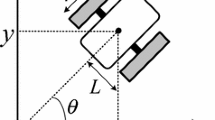Abstract
This paper addresses the time-optimal motion planning (TOMP) problem between two configurations for a mobile robot with two independently driven wheels. Different from previous methods, in which one needs to solve a set of differential equations, a discrete method is proposed to solve this problem. The first step is to transform the TOMP problem into a nonlinear programming (NLP) problem by an iterative procedure, in which the sampling period and the control inputs are chosen as variables, and the traveling time is to be minimized. Since it is usually hard to find initial feasible solutions of an NLP problem, a method that combines the concepts of genetic algorithms (GAs) and penalty functions is also proposed. In this manner, the NLP problem can be solved since initial feasible solutions can be generated easily. Simulation results are included to show the validity of the proposed method.
Similar content being viewed by others
References
Chung, T. S. and Wu, C. J.: A computationally efficient numerical algorithm for the minimumtime control problem of continuous systems, Automatica 28 (1992), 841-847.
Desaulniers, G. and Soumis, F.: An efficient algorithm to find a shortest path for a car-like robot, IEEE Trans. Robotics Automat. 11(6) (1995), 819-828.
Fogel, D.: An introduction to simulated evolutionary optimization, IEEE Trans. Neural Networks 5 (1994), 3-14.
Fourquet, J. Y. and Renaud, M.: Time-optimal motions for a torque controlled wheeled mobile robot along specified paths, in: Proc. of IEEE International Conf. on Decision and Control, 1996, pp. 3587-3592.
Gen, M. and Cheng, R.: Genetic Algorithm and Engineering Design, Wiley, New York, 1997.
Gen, M. and Cheng, R.: A survey of penalty techniques in genetic algorithms, in: Proc. of IEEE ICEC, 1996, pp. 804-809.
Goldberg, D. E.: Genetic Algorithms in Search, Optimization and Machine Learning, Addison-Wesley, Reading, MA, 1989.
Grefenstette, J. J.: Optimization of control parameters for genetic algorithms, IEEE Trans. Systems, Man, Cybernet. 16(1) (1986), 122-128.
Holland, J.: Adaptation in Natural and Artificial Systems, University of Michigan Press, Ann Arbor, 1975.
Homaifar, A., Lai, S. H. Y., and Qi, X.: Constrained optimization via genetic algorithms, Simulation 62(4) (1994), 242-254.
Janikow, C. and Michalewicz, Z.: Specialized genetic algorithms for numerical optimization problems, in: Proc. of IEEE International Conf. on Tools for AI, 1990, pp. 798-804.
Joines, J. A. and Houck, C. R.: On the use of non-stationary penalty functions to solve nonlinear constrained optimization problems with GAs, in: Proc. of IEEE ICEC, 1994, pp. 579-584.
Jung, M. J., Shim, H. S., Kim, H. S., and Kim, J. H.: The miniature omni-directional mobile robot OmniKity-I (OK-I), in: Proc. of IEEE International Conf. on Robotics and Automation, 1999, pp. 2686-2691.
Keigo, W. and Iyotaka, I.: A survey of robotic control systems constructed by using evolutionary computations, in: Proc. of IEEE International Conf. on Systems, Man, and Cybernetics, Vol. 2, 1999, pp. 758-763.
Luenberger, D. G.: Linear and Nonlinear Programming, Addison-Wesley, Reading, MA, 1973.
Man, K. F., Tang, K. S., and Kwong, S.: Genetic algorithms: Concepts and applications, IEEE Trans. Industrial Electronics 43(5) (1996), 519-534.
Michalewicz, Z.: Genetic Algorithm + Data Structure = Evolution Programs, 3rd edn, Springer-Verlag, New York, 1996.
Pontryagin, L. S., Boltyanskii, V. G., Gamkrelidze, R. V., and Mishchenko, E. F.: The Mathematical Theory of Optimal Processes, Gordon and Breach, New York, 1986.
Powell, D. and Skolnick, M. M.: Using genetic algorithms in engineering design optimization with non-linear constraints, in: Proc. of the Fifth ICGA, 1993, pp. 424-430.
Reister, D. B. and Pin, F. G.: Time-optimal trajectories for mobile robots with two independently driven wheels, Internat. J. Robotics Res. 13(1) (1994), 38-54.
Renaud, M. and Fourquet, J. Y.:Minimum time motion of a mobile robot with two independent, acceleration-driven wheels, in: Proc. of IEEE International Conf. on Robotics and Automation, 1997, pp. 2608-2613.
Schoenauer, M. and Xanthakis, S.: Constrained GA optimization, in: Proc. of the Fifth ICGA, 1993, pp. 573-580.
Schwefel, H.: Evolution and Optimum Seeking, Wiley, New York, 1994.
Sheble, G. B. and Britting, K.: Refined genetic algorithm-economic dispatch example, IEEE Trans. Power Syst. 10 (1995), 117-124.
Souères, P. and Laumond, J. P.: Shortest paths synthesis for a car-like robot, IEEE Trans. Automat. Control 41(5) (1996), 672-688.
Wu, W., Chen, H., and Woo, P. Y.: Optimal motion planning for a wheeled mobile robot, in: Proc. of IEEE International Conf. on Robotics and Automation, 1999, pp. 41-46.
Zheng, Y. and Moore, P.: The design of time-optimal control for two-wheel driven carts tracking a moving target, in: Proc. of IEEE International Conf. on Decision and Control, 1995, pp. 3831-3836.
Author information
Authors and Affiliations
Rights and permissions
About this article
Cite this article
Liu, GY., Wu, CJ. A Discrete Method for Time-Optimal Motion Planning of a Class of Mobile Robots. Journal of Intelligent and Robotic Systems 32, 75–92 (2001). https://doi.org/10.1023/A:1012067328948
Issue Date:
DOI: https://doi.org/10.1023/A:1012067328948




